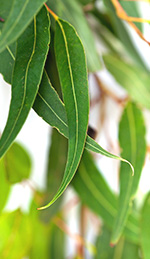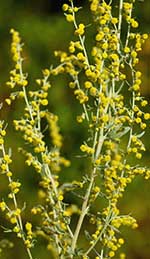 Yes, radiata is a type of eucalyptus—but its chemical composition is different enough from Eucalyptus globulus that we have elected to offer radiata essential oil separately, as its very own product. Even plants belonging to the same genus can produce very different essential oils at the species level; for example, take sweet annie and wormwood oil: while both plants belong to the genus Artemisia, their essential oils contain a distinct range of compounds that have different effects. In the case of the eucalyptuses, Eucalyptus radiata is widely considered to have a sweeter, gentler scent that lacks the more medicinal overtones of its famous cousin Eucalyptus globulus. Radiata essential oil is often used to treat the same conditions as eucalyptus oil in people who are too sensitive to the camphoraceous scent of eucalyptus.
Yes, radiata is a type of eucalyptus—but its chemical composition is different enough from Eucalyptus globulus that we have elected to offer radiata essential oil separately, as its very own product. Even plants belonging to the same genus can produce very different essential oils at the species level; for example, take sweet annie and wormwood oil: while both plants belong to the genus Artemisia, their essential oils contain a distinct range of compounds that have different effects. In the case of the eucalyptuses, Eucalyptus radiata is widely considered to have a sweeter, gentler scent that lacks the more medicinal overtones of its famous cousin Eucalyptus globulus. Radiata essential oil is often used to treat the same conditions as eucalyptus oil in people who are too sensitive to the camphoraceous scent of eucalyptus.
Both Eucalyptus radiata and E. globulus are evergreen trees native to Australia [1]. Radiata has lance-shaped glossy green leaves and grayish brown bark that comes off in parchment-like layers, which is why it’s sometimes also known as the “paperbark” tree. In the wild, radiata trees grow to an average height of 15 meters (48 feet), and occasionally can reach heights of 30 meters (97 feet)[2]!
Australian aborigines used a wide variety of plant medicines in traditional medicine. Eucalyptus was one of the first and foremost of these, used to treat ailments from aching muscles and sore joints to respiratory infections, burns, and open wounds [2]. One common practice was to crush eucalyptus leaves into a poultice that could be applied to cuts and wounds to speed healing and prevent infections due to antimicrobial compounds in the leaf. Eucalyptus leaves were also burned and the vapors inhaled to treat fevers, and a distillation of eucalyptus leaves in water was often consumed to relieve menstrual cramps and stomach upset [2].
There are 6 known chemotypes of radiata oil [1], each with a slightly different ratio and composition of compounds; the chemotype we offer at Essential Oil Exchange contains naturally high levels of piperitone, used to synthesize the antimicrobial compounds menthol and thymol, which are found in mouthwashes, lozenges and commercial disinfectants [2]. Radiata essential oil also contains phellandrene, camphene, cymene, terpinene, and thujene.
The oil of radiata is used in aromatherapy as an analgesic rub for sore muscles and joints due to its anti-inflammatory [3], warming, and circulatory stimulant properties. Radiata oil is also inhaled in diffusion to support the immune system [3] and treat respiratory infections [2] and conditions ranging from sinusitis to nasal catarrh and chest congestion, especially wet congestion resulting from the production of excess mucus. The vapor of radiata oil can help clear this congestion by acting to regulate mucus secretion [4]. The oil is also sometimes diffused outdoors as an insect repellent [2], along with lemongrass and citronella oil.
Finally, we couldn’t conclude this article without mentioning some of the lovely blendings radiata oil makes with other essential oils! Aromatherapists often enhance the efficacy of essential oils by combining them to create a therapeutic synergy, and radiata oil is no exception. A blend of radiata oil with similar antimicrobial and expectorant essential oils such as Eucalyptus globulus, peppermint, and thyme may be invaluable in staving off winter colds while invigorating the senses and relieving general feelings of sluggishness and apathy. For a blend with enhanced anti-inflammatory and circulatory stimulant effects, a small quantity of radiata essential oil may be blended in a carrier oil with ginger, marjoram, Roman and German chamomile, and black pepper oil.
REFERENCES
1. “Eucalyptus radiata.” Wikipedia. Last modified February 18th, 2014. http://en.wikipedia.org/wiki/Eucalyptus_radiata
2. “Eucalyptus Radiata Essential Oil”. Quinessence Aromatherapy. Accessed April 22nd, 2014. http://www.quinessence.com/blog/eucalyptus-radiata-essential-oil.
3. Serafino, A., PS Sinibaldi Vallebona, F Andreola, M Zonfrillo, L Mercuri, M Federici, G Rasi, E Garaci and P Pierimarci. 2008. “Stimulatory effect of Eucalytpus essential oil on innate cell-mediated immune response.” BMC Immunology 9 (17).
4. Juergens, Uwe R., Tanja Engelen, Kurt Racké, Meinolf Stöber, Adrian Gillisser, Hans Vetter. October 2004. “Inhibitory activity of 1,8-cineole (eucalyptol) on cytokine production in cultured human lymphocytes and monocytes.” Pulmonary Pharmacology and Therapeutics 17 (5): 281-87.

